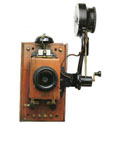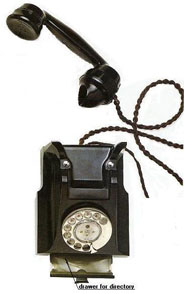

 Wall-mounted Phone |
The telephone is a devices for electrically transmitting voice communications over wire and is based on the fact that the human voice vibrates air. For centuries, people have tried to send signals over long distances, using bonfires and flashing mirrors to carry messages. It was Frenchman Claude Chappe who in 1793 devised the word telegraph (literally, writing at a distance) to describe his message machine. Moving arms mounted on towertops signaled numbers and letters. Over the next 40 years, electrical telegraphs were developed. |
|
The first operational telephone was patented and produced in the United States in 1876 by Alexander Graham Bell. Enabling speech to be sent along wires for the first time, Bell's work with the deaf led to an interest in how sounds are produced by vibrations in the air. His research on a device called the "harmonic telegraph" led him to discover that electric current could be change to resemble the vibrations made by a speaking voice. That was the principle on which his work on the telephone was based on. Early models like Bell's "Box telephone" of 1876-77 had a trumpet-like mouthpiece and earpiece combined. The instrument contains a membrane that vibrated when someone spoke into the mouthpiece. The changing vibration varied an electric current in a wire, and the receiver turned the varying current back into vibrations that you could hear. In 1877 Thomas Edison developed different mouthpiece and earpiece units. Models such as this were hung from a special switch that disconnected the line on closing. He then invented the wall-mounted telephone in 1879. It has a microphone and receiver of his design. The user had to wind the handle while listening. A ring og the bell indicated an incoming call or an successful connection. Only by 1885, the transmitter and receiver had been combine to form a handset. At first it was all metal, but by 1929 plastic handsets were common. |
 Cradle telephone |